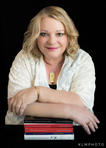Christy K. Robinson's Blog: William & Mary Barrett Dyer--17th century England & New England, page 23
October 18, 2011
Mary Dyer's Other Friends
I'm pleased to presenta guest post by "Hay Quaker," whose blogI've enjoyed reading since he discovered the Facebook pagefor Mary Barrett Dyer that I administer, and became her Facebook friend.Whether it's his own article, or one of the many quotations he posts, it'salways food for meditation, and sometimes the impetus for further study. Thank you, Ray, and I hope you'll favor the Dyers'readers again in the future. (In the meantime, you can follow his blog.)
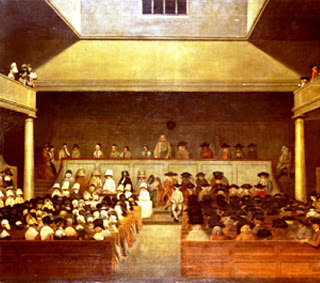 1670s-A meeting of the Religious Society of Friends (Quakers)
1670s-A meeting of the Religious Society of Friends (Quakers)at Gracechurch Street, London
© Ray Lovegrove* (usein this site by author's permission)
Williamand Mary Dyer were remarkable people in many ways, as regular readers of thisblog will not need reminding. It is, perhaps, their travel across the AtlanticOcean not once, but twice, that would have singled them out as particularlyunusual in their age. Mary became a Quaker during her return to England[1652-57] following her witnessing of George Fox preaching; so herfirst trip to America was as a Puritan and her second as a Quaker.
Inthe fifty years between 1675 and 1725, many Quakers left Britain and cameto settle the Delaware River area of Pennsylvania and into western New Jersey.It is estimated that about 23,000 Quakers left Britain during this migration,about eighty percent of them coming from the counties of Yorkshire, Cheshire,Lancashire in the north of England and Staffordshire, Derbyshire andNottinghamshire in the English Midlands.
[image error] 1654-Quakerism in England and Wales A further ten percent were from Wales and Ireland. The rest came fromcounties scattered across England, but there were none from the EasternCounties of England (East Anglia), the heart of the Puritan movement. Therewere a small number of Quakers to be found in New England prior to this; theywere not Friends to start with, rather came over as Puritans, later 'converted'by Quaker missionaries mainly from 1655–1670.
Thereasons for this Atlantic migration are not hard to understand; the forces 'pushing'Friends towards the New World would have included persecution and lack ofreligious freedom in Britain. The'pulling' forces would have doubtless been the promise of a new start, thepossible economic benefits of life in America, and the ultimate hope ofstarting new Quaker communities where like minded people could develop livestogether, both in a spiritual and practical sense. The history of thesemigrants, and those adopting Quakerism in America is well known, but what ofthose left behind?
Inthe North of England and the Midlands, so many Friends took up the challenge ofa life in the 'New World' that it had a devastating effect on many Meetings.The fact that a relatively small number of areas lost Friends in the migrationwould have made even more dramatic the impact on many communities, to an extentthat was observable even to those who were not Friends. Inevitably it was the young, fit andpresumably the more wealthy Quakers who made the journey, leaving behind theelderly, the infirm and the poor. Families would have been split up and thoseFriends who migrated would have said goodbye to loved ones in the fullknowledge that the chance of ever seeing them again was remote. Communications'home' would have come by letter or as news brought by the very rare visitors(of which George Fox himself was one (1671-73). These visits aside, newsbetween Quakers on both continents would have been slow, inconsistent andsometimes not at all.
EarlyAmerican Friends had an influence on the history and development of theirnation far greater than their numbers might have suggested. Influential Quakerslike William Penn are justifiably looked upon as numbering among those whohelped build America. In Britain, however, Quakers' influence was limited. Excludedfrom studying at Universities unless they denied their Quaker beliefs andjoined the Church of England, Quakers in Britain exercised influence not ingovernment, but in the areas of commerce and industry, many becoming importantplayers in the Industrial Revolution. Most of the leading UK banks were foundedby Quakers and chocolate manufacture was for many years a virtual Quakermonopoly.
Quakernumbers in Britain have never reached high levels (estimated currently to be16,000 in the UK, compared to an estimated 93,000 in the USA) and perhaps thatmass migration to America has had a bearing on this. Certainly many parts ofEngland and Wales that were once strong Quaker regions, later to becameMethodist strongholds, perhaps following the preaching of John Wesley in theeighteenth century, perhaps due in part to depleted Quaker numbers followingmigration.
Whenthe visionary American Quaker John Woolman visited England in 1772 he was notentirely pleased with what he found in relation to Friends' involvement withcommerce and industry. He wrote in his Journal;
"I have felt great distress of mind since I came on this island, onaccount of the members of our Society being mixed with the world in varioussorts of traffic, carried on in impure channels. Great is the trade to Africafor slaves; and for the loading of these ships a great number of people areemployed in their factories, among whom are many of our Society. Friends inearly times refused on a religious principle to make or trade in superfluities,of which we have many testimonies on record; but for want of faithfulness,some, whose examples were of note in our Society, gave way, from which otherstook more liberty. Members of our Society worked in superfluities, and boughtand sold them, and thus dimness of sight came over many; at length Friends gotinto the use of some superfluities in dress and in the furniture of theirhouses, which hath spread from less to more, till superfluity of some kinds iscommon among us.In this declining state many look at the example of others and toomuch neglect the pure feeling of truth. Of late years a deep exercise hathattended my mind, that Friends may dig deep, may carefully cast forth the loosematter and get down to the rock, the sure foundation, and there hearken to thatdivine voice which gives a clear and certain sound; and I have felt in thatwhich doth not receive, that, if Friends who have known the truth, keep in thattenderness of heart where all views of outward gain are given up, and theirtrust is only in the Lord, he will graciously lead some to be patterns of deepself-denial in things relating to trade and handicraft labour; and others whohave plenty of the treasures of this world will be examples of a plain frugallife, and pay wages to such as they may hire, more liberally than is nowcustomary in some places."John Woolman died during this trip to Great Britain; for this author atleast, his visit represents one of the greatest gifts of American Friends toQuakers in these Isles. In pointing out the differences between British andAmerican Friends he also underlined those things that keep us as Quakers –wherever we live – and his advice still gives us cause to stop and think.Thelevel of writing and journal keeping by both British and American Quakers isremarkable and provides us with a richly illustrated history, but also someconsiderable inspiration. Today with the advent of Facebook and Twitter,Quakers from all over the world are able to communicate (be that exchanginginformation or taking part in that age-old Quaker pastime – arguing) on a dailybasis, hopefully with "the pure feeling of truth" always being present.Those close to the geographical roots of Quakerism are, at last, able tocommunicate freely with the most fruitful of the branches._______________________© Ray Lovegrove 2011,used by permission RayLovegrove (aka 'Hay Quaker') is a Quaker living in Hay-on-Wye, on the border between Wales andEngland. http://www.facebook.com/hay.quaker http://hayquaker1.blogspot.com/
Published on October 18, 2011 23:11
October 12, 2011
Eight is Enough, especially in bed
I'm pleased to present the FIRST of a series of guest posts by some special friends who are knowledgeable about the culture of the 17th century, during which William and Mary Dyer lived their remarkable lives. Jo Ann Butler has kindly written this post based on her university degree in archaeology and research for the trilogy of historical novels she's writing (see footnote).
© Jo Ann Butler* (use in this site by author's permission)
We've all lived without electricity and heat for the duration of a poweroutage. A few of us have done so for longer, perhaps tenting in the woods for afew days, or a week at scout camp. I'll bet that you were grateful to get hometo light, warmth, and tap water.
I spent a summer in a tent during my student archaeologist years. My crew bathedin a pond, cooked on a propane stove, and swatted mosquitoes as we cataloguedartifacts under a string of bare light bulbs. It was a memorable experience,but I enjoyed it. If it had been January rather than July, my memories wouldhave been far less pleasant.
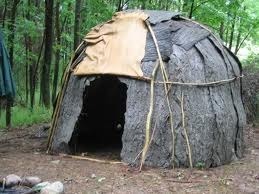 A wigwam of poles and reed mats
A wigwam of poles and reed matsMy primitive summer was voluntary, but people in the 17th century knew no otherlife. Mary and William Dyer neverfelt the joy of hot water piped into their home, and they couldn't turn up thethermostat on a cold night. Firewood, quilts, and body heat were all that keptthe Dyers warm at night.
When the Dyers landed at Bostonin 1635 and picked out a home lot, they needed shelter as quickly as possible.They may have lived with friends in the town, or in a tent like I did, or they may have used an Indian-stylewigwam. To make a wigwam, create a tunnel by jabbing two rows of poles into the ground, bend themover, and then tie them at the top. Cover them and close one end of the tunnelwith woven reed mats, and use another mat or a deer hide for a door. The wigwamwasn't warm or waterproof, but the occupants could be under cover in a day.
A dugout was hard work to make, but would last two or three years, and it waswarmer. Dig a hole into a hillside, tall enough to stand inside, and as wideand long as you wish. Line it with sawed planks or bark slabs. Close the openside of the pit with a plank wall equipped with a door. Roof it with polerafters covered with bark, thatch, or turf. Dugouts were damp and dark, forthey were often built without windows. However, their inhabitants were safelyindoors.
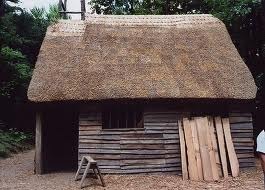 Reconstruction of a colonial house
Reconstruction of a colonial house in Plymouth, Massachusetts.
With the family's first shelter built, the Dyers turned their attention to amore permanent home. Houses were small in New England'searly years for sensible reasons. A small home is more quickly built, and iseasier to keep warm than a large one. The Dyers' first house was probably asingle room structure, with a squared timber frame. The walls were sawedplanks, or withy filled in with a latticework of twigs slathered with mud.Forget about log cabins – that building style was not used in New England. The walls probably rested on timber sills set into theground, and the home had either a plank flooring, or bare dirt.
The size of the one-room home depended on the size of trees availableand how much time the owner (or the men he hired to build the home) wishedto spend on sawing planks and squaring timbers for the frame. Even a 12'x16'interior would serve for a small family, with rooms added later as the familygrew.
The Dyers' home was heated by a wood fire laid on hearthstones on the shortside of the home. Chimneys were a rather new innovation when the Dyers came to Boston. Formerly, smokeescaped from a house via a hole cut into the roof, but William and Maryprobably had a chimney built of logs plastered with mud. Such "cat and clay"chimneys were easier to build than stonework, but if the clay coating cracked,disastrous fires were the result.
It was hard to keep even a small room warm with a wood fire,especially during winter storms. The simplest way to sleep warm at night? Pileall of the family members into a single bed. Mary and William Dyer had sixchildren who survived infancy (born 1635, 1640, 1643, 1647, 1648, and 1650).
In warmer weather, a family's older children may havepreferred to find less crowded sleeping spots, especially after the family homewas expanded, but parents and younger children often shared a common bed. If thefamily had company overnight, they may have shared the communal covers.Privacy, as we know it, barely existed, unless the family was prosperous--as the Dyers were. [image error] Chamber pot
Let me close with one more factoid about my primitive summer. With no plumbingbut a well, several times a day we faced a 1000-yard walk to the privy. The 17th-century privy was probably much nearer to the house. Therewas far less concern with how close one's outhouse lay to one's drinking water.During their cold winter nights, the Dyers would use chamber pots, and thenempty them in the morning. No matter how nostalgic I feel about the 17thcentury, or even my summer's campout, when I think of Mary and William Dyer'sfrigid, drafty outhouse, I am grateful for modern plumbing!
_____________ *Jo Ann Butler, of Fulton, New York, is author of Rebel Puritan, the first in a historical novel series about Herodias Long HicksGardner, who lived in Massachusetts and Rhode Island and knewthe Dyers. www.rebelpuritan.com
Published on October 12, 2011 22:54
October 7, 2011
William and Mary Dyer's 17th-century bookshelf
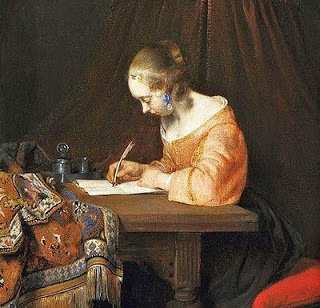 1655-Woman Writing a Letter,
1655-Woman Writing a Letter, by Gerard Terborche
© Christy K. Robinson The first settlers of New Englandwere avid readers. On long winter evenings, or rainy summer days, books weretreasured for intellectual stimulation and entertainment value.
William and Mary Dyer were very well-educated for their timeand social class. In an era when only some people could read, and fewer peoplecould write, their penmanship is strong and clean, without scratch-outs,indicating that they thought carefully and focused on what they were writing.They make reference to the Bible and history. William was well-versed ongeography and animal and marine species. Mary was highly-regarded for herintellect.
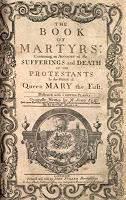
While we don't know precisely which books the Dyers read intheir youth or adulthood, I've listed books that were very likely on theirreading list, published before or during their lifetimes (just arepresentation of hundreds or thousands of books which would have beenavailable at the time). The hyperlinks take you to the online versions—searchable—manyof them free downloads.
Bookof Martyrs—John Foxe The Holy Bible,Geneva versionThefirst blast of the trumpet against the monstrous regiment of women—JohnKnox TheBook of Sports—King James Daemonologie—KingJames TheAdvancement of Learning—Francis Bacon TheEnglish Housewife—Gervase MarkhamAnew booke of Cookerie—John MurrellTheQueen's Closet Opened—Queen Henrietta Maria Wonderworking providence of Sions Saviour in New England—EdwardJohnson
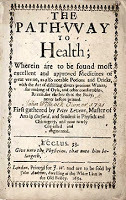 Religiomedici—Sir Thomas Browne Newesfrom America—Captain John UnderhillNewEngland's Prospect—William WoodGoodNewes from New England—Edward WinslowThe First Planters of New England—JohnWinthropShortStory of the Rise, Reign and Ruin of the Antinomians, Familists and Libertines—JohnWinthrop ThePathway to Health—Peter LevensAHealing Question—Henry Vane TheCompleat Angler—Izaak Walton
Religiomedici—Sir Thomas Browne Newesfrom America—Captain John UnderhillNewEngland's Prospect—William WoodGoodNewes from New England—Edward WinslowThe First Planters of New England—JohnWinthropShortStory of the Rise, Reign and Ruin of the Antinomians, Familists and Libertines—JohnWinthrop ThePathway to Health—Peter LevensAHealing Question—Henry Vane TheCompleat Angler—Izaak Walton
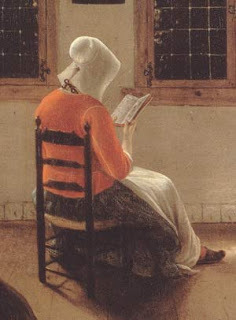
Published on October 07, 2011 05:00
October 3, 2011
All the fun a Puritan can stand
© Christy K. Robinson
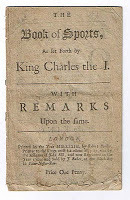 In 1618, King James of England published The Book of Sports, a pamphlet that promotedrecreation on Sundays after church services. Most English people worked 12 ormore hours per day, six days a week. Puritan worship practices were to attendservice for hours in the morning, have a lunch break, and then sit for two ormore hours through more teaching and preaching before going home. Servants ofPuritan masters were oppressed with no leisure time, no recreation, no timeaway from their employers. In 1632, James' son, King Charles I, with thesupport of William Laud, Archbishop of Canterbury, reissued
The Book of Sports
,but with the injunction that it be read aloud in all churches, or the ministerswould be deprived of income, and probably imprisoned. "People are governed bythe pulpit more than the sword," said King Charles in 1638.
In 1618, King James of England published The Book of Sports, a pamphlet that promotedrecreation on Sundays after church services. Most English people worked 12 ormore hours per day, six days a week. Puritan worship practices were to attendservice for hours in the morning, have a lunch break, and then sit for two ormore hours through more teaching and preaching before going home. Servants ofPuritan masters were oppressed with no leisure time, no recreation, no timeaway from their employers. In 1632, James' son, King Charles I, with thesupport of William Laud, Archbishop of Canterbury, reissued
The Book of Sports
,but with the injunction that it be read aloud in all churches, or the ministerswould be deprived of income, and probably imprisoned. "People are governed bythe pulpit more than the sword," said King Charles in 1638. This was a serious blow to Puritans (as it was meant to be),and it sparked the Great Migration to New England.When Rev. John Cotton refused to comply, he went into hiding for a year beforehis emigration, and ten percent of the citizens of Boston,Lincolnshire, followed his flight to New England.
'Puritans' opposition to sport wasgrounded on at least seven propositions: sport was frivolous and wasted time;sport did not refresh the body as good recreation should, but tired peopleinstead; much sporting activity was designed deliberately to inflict pain or injury;sporting contests usually led to gambling; more sport took place on Sunday thanon any other day, so, sport encouraged people to defile the Sabbath; sport wasnoisy and disrupted others, sometimes entire communities; and many sports hadeither pagan or "Popish" origins.' ~Bruce C. Daniels, Puritansat Play , p. 166.
America'sPuritan colonists in the 17th century were opposed to ball sports because ofthe risk of injury and betting. They forbade blood sports (dog fights,bear-baiting, cock fighting), not so much from concern about animal cruelty, butbecause of the gambling attached to them. They condemned theater(cross-dressing because men played women's parts, and sexual immorality)and organ music in church (distracted from Bible reading and preaching,inflamed the senses toward the emotional rather than the intellectual).
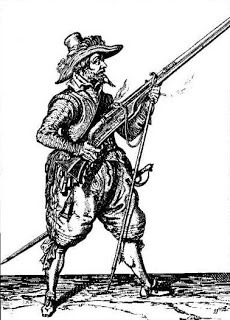
American Puritans approved of hunting, marksmanship, wrestling,and fishing. Their militia drill days were festivals in manly pursuits ofwarfare, and womanly cooking and marketing of home products.
What did New England womendo for sport? Quilting, spinning, and sewing bees were productive and a greattime for laughing and talking. There were speed-spinning competitions. Some sewingbees would have been occasion for the Bible studies that Anne Hutchinson got introuble for, in mid-1630s Boston.
At home with the family, they loved reading aloud in theevening. At first, the books of choice were the Geneva Bible and Foxe's Book ofMartyrs, but soon, books and broadsheets were shipped to Boston, and sold, traded, loaned, and readover and over.
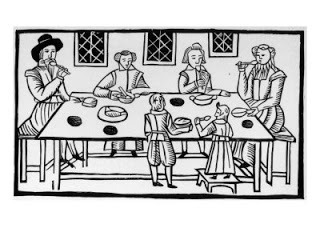 The Sabbath was a long day of preaching, punctuated by lunchat the meetinghouse—we'd call it a potluck or fellowship meal today. And whenfamilies came to church from some distance in the wagons, it wasn't practicalto go home for lunch. So the Sabbath dinners were a time to show off cookingskills.
The Sabbath was a long day of preaching, punctuated by lunchat the meetinghouse—we'd call it a potluck or fellowship meal today. And whenfamilies came to church from some distance in the wagons, it wasn't practicalto go home for lunch. So the Sabbath dinners were a time to show off cookingskills. When homes and outbuildings were raised, it was turned intoa community activity with men competing in carpentry and weight-lifting skills,and women competing with foods, or speed-sewing sprints.
Group dancing, particularly at weddings, was acceptable insome communities, but not usually between unmarried men and women. In someareas, though, the ministers condemned dancing as too frivolous for end-times,when people ought to be soberly aware of the impending apocalypse and judgment.
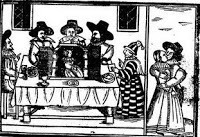 What about drinking? you ask. Alcoholic drinks wereextremely low in alcohol, about four percent. Everyone, including children,drank fermented cider, beer, ale, and wines, but usually not to excess. Privateparties combined with over-imbibing often led to fornication and adultery. Thosewho did become drunk and misbehave (sexual affairs, homosexuality, or violent behavior) were tried by their church, put in stocks, whipped, or inan extreme case, made to wear a scarlet letter D for a year. Overall, thepreference for mild alcoholic beverages probably saved many lives, consideringwater-borne illnesses and parasites. Distillation of spirits and the resulting concentration of alcohol and its effects came to Newport when the Caribbean molasses were refined there. Newport gained a reputation for drunken mariners and prostitution.
What about drinking? you ask. Alcoholic drinks wereextremely low in alcohol, about four percent. Everyone, including children,drank fermented cider, beer, ale, and wines, but usually not to excess. Privateparties combined with over-imbibing often led to fornication and adultery. Thosewho did become drunk and misbehave (sexual affairs, homosexuality, or violent behavior) were tried by their church, put in stocks, whipped, or inan extreme case, made to wear a scarlet letter D for a year. Overall, thepreference for mild alcoholic beverages probably saved many lives, consideringwater-borne illnesses and parasites. Distillation of spirits and the resulting concentration of alcohol and its effects came to Newport when the Caribbean molasses were refined there. Newport gained a reputation for drunken mariners and prostitution. But the joy in every New Englandman's heart came from sport fishing, in ponds, rivers, lakes, and the ocean,according to the author of Puritans atPlay.
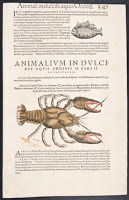 Fishing was both favorite pastime for men, and an importantindustry. Fishing, whaling, shipbuilding, and import/export of essential goodswere vital to the development of New England. Often,stores of fruit, vegetables, grain, and meat from the fall slaughters had runout before the summer harvests began, and the people turned to the disdainedfood of poor people: lobsters.
Fishing was both favorite pastime for men, and an importantindustry. Fishing, whaling, shipbuilding, and import/export of essential goodswere vital to the development of New England. Often,stores of fruit, vegetables, grain, and meat from the fall slaughters had runout before the summer harvests began, and the people turned to the disdainedfood of poor people: lobsters. 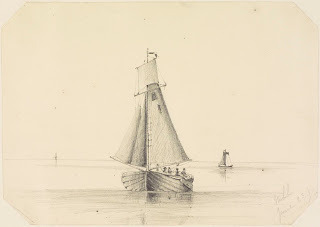 Fishing vesselWhen several failed harvests (at the peak of the Little IceAge), and the population explosion of the Great Migration combined to threatenwidespread famine and disease, Rev. Hugh Peter of Salem, Massachusetts, broughtthe bulk of fish processing and shipbuilding south, from French territories onCanada's east coast, to ports of Salem, Cape Ann, and Boston, thus enrichingthe economy of Massachusetts Bay for generations to come.
Fishing vesselWhen several failed harvests (at the peak of the Little IceAge), and the population explosion of the Great Migration combined to threatenwidespread famine and disease, Rev. Hugh Peter of Salem, Massachusetts, broughtthe bulk of fish processing and shipbuilding south, from French territories onCanada's east coast, to ports of Salem, Cape Ann, and Boston, thus enrichingthe economy of Massachusetts Bay for generations to come. How convenient that WilliamDyer was a dues-paying member of London'sWorshipful Company of Fishmongers! His nine-year apprenticeship in theprestigious guild was an advanced education in business management and foreigntrade, though surely he was extremely knowledgeable about fish! He and MaryDyer were among the co-founders of Newport, Rhode Island in 1639, a port that traded with Europe andthe West Indies. What did they export? Lumberfor shipbuilding, furs, horses, fish, and whale oil.
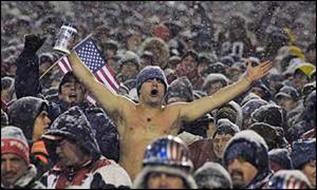 Colonial New England fun(sanctioned fun, anyway) was constructive and productive. It makes one wonderabout what they'd think of their successors and descendants, painting theirbodies in freezing weather and cheering for the New England Patriots, joyfully scrapping in hockey fights, orworshiping the Sox in their bikinis in the summer heat.
Colonial New England fun(sanctioned fun, anyway) was constructive and productive. It makes one wonderabout what they'd think of their successors and descendants, painting theirbodies in freezing weather and cheering for the New England Patriots, joyfully scrapping in hockey fights, orworshiping the Sox in their bikinis in the summer heat.
Published on October 03, 2011 21:28
September 23, 2011
The 1630 Comet of Doom
© Christy K. Robinson
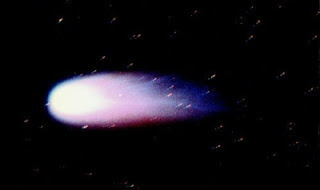 When we hear theprediction of a comet, many of us set an alarm to wake up at oh-dark-thirty, gooutside with a telescope, and peer at blurry blobs on the horizon. I did thatseveral times, for Halley's, Ikeya-Zhang, and Hale-Bopp. The best I couldrecognize with binoculars was a tiny, glowing cotton ball. But life went on asusual each time, because our culture no longer associates doom with a chunk oficy dust passing through our solar system.
When we hear theprediction of a comet, many of us set an alarm to wake up at oh-dark-thirty, gooutside with a telescope, and peer at blurry blobs on the horizon. I did thatseveral times, for Halley's, Ikeya-Zhang, and Hale-Bopp. The best I couldrecognize with binoculars was a tiny, glowing cotton ball. But life went on asusual each time, because our culture no longer associates doom with a chunk oficy dust passing through our solar system. For thousands of years, a comet was believed to presagedeath, disease, famine, and war. It was considered by many cultures to be asign of divine favor or judgment.
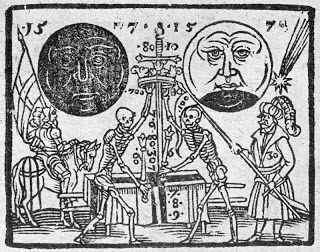 1607 Halley's Comet (though it wasn't yet named for Halley):
1607 Halley's Comet (though it wasn't yet named for Halley): Note the skeletons (death), the crown, the sword, and
the warriors connected with the comet.A noon-time comet was reported in England,Germany, and Italy on May 29and 30, 1630. It was said to resemble a second sun and to shine sobrightly that there was a double shadow.
The comet of 1630 was described by Abbot Assi of Milan as a blazing star,with a "savage face," and of a "horificaspecie," ("horrific kind"). He said that it preceded "de peste quae fuit anno1630" ("the pestilence which was the year 1630").
Sure enough, in Englandand much of Europe, plague and famine followedthe comet sighting.
Mary Barrett, age 19, and William Dyer, 21, who didn't marryuntil 1633, lived in Londonat the time of the comet, and they almost certainly witnessed it. In thebubonic plague which struck Europe and Englandthat year, they came through unscathed, though surely they lost friends andrelatives when a third of London's citizens died. Perhaps they fled the city forsome months, like other people who had the financial means to do so. (There will be another post soon, specifically about plagues.)
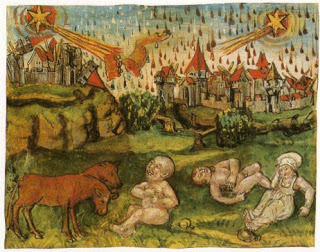 Germany in 1513.Note the blood dripping from the sky
Germany in 1513.Note the blood dripping from the skyand the two-headed animal, a"monster" that was a sign
of God's judgment against heresy. The middle personin the
foreground has the buboes of the Black Death. Trees have been
broken,and several towers have fallen, probably in earthquakes.
These things happened, it was believed, because of the comets.In New England, about 300of the 1000 settlers in Massachusetts Bay Colony died of fever, scurvy, andaccident, and their winter of 1630-31 was called The Starving Time. Consideringthat they'd emigrated to Americato found a New Jerusalem, the colonists must have wondered how they haddispleased God, to be visited so harshly.
Stars and comets also were believed to mark special datesconnected with world events, like births or deaths of kings. Some think it wasHalley's Comet that shown in the sky over Bethlehem in 12 BC.
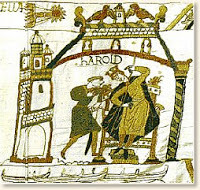 The 1066 Halley's comet,
The 1066 Halley's comet, depicted in Bayeux Tapestry. The
English believed it prophesied doom.Halley's Comet, said tobe four times the size of Jupiter, showed itself in 1066, a year of cataclysmin England,as Edward the Confessor died and Harold was anointed king in violation of hisoath of fealty to William "The Conqueror," Duke of Normandy. William won thecrown for himself later that year.
The first comet toappear in the heavens of New England, of which there is any account, blazedforth from Orion from the ninth to the twenty-second of December, 1652. It waslarge, and people shuddered when they looked at its beautiful tail of fire.
The people connectedtheir appearance with some famine, plague or disaster, either as its directcause or precursor; and the learned men of the times taught the people to feartheir approach. When it is considered that some persons are still disturbed attheir coming in this very end of the nineteenth century, it is readilyunderstood why the people of the days when superstition was fostered trembledat their appearance. They seemed to be the perfection of instruments toaccomplish the burning of the world.
The clergy of NewEngland sought to make the most of this belief and fear, either hypocritically,to simply increase the membership of their churches, or because they shared thecommon belief and honesty endeavored to have souls prepared for the greatchange that might come immediately, and without further warning. At theseperiods many were brought into the fold, and the ordinances and services of thechurch were more carefully observed. –The Essex [Massachusetts]Antiquarian magazine, 1898, edited by Sydney Perley
Other momentous events, not necessarily negative, were associated with comets. When the noon-day comet appeared in May 1630, it was believed to mark thebirth of Charles II, the son of the English King Charles I and his queenHenrietta Maria.
After the EnglishCivil War of the 1640s, the execution of Charles I, and Oliver Cromwell's Protectorate, Charles II had beenrestored to the monarchy for some months before his coronation, which wasplanned for his birthday, May 30, 1660. The publicity lauded him as a sortof messiah unifying the war-torn kingdom, and mentioned the 1630 birth comet as proof of him being God's choice foranointed king.
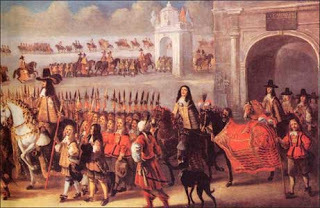 Charles II coronation procession, May 30, 1660.
Charles II coronation procession, May 30, 1660. It looks very messianic with the white gate and clouds.The poet Waller referred to the comet in his coronationpoem, "On St. James's Park," in the lines, His thoughts risehigher, when he does reflectOn what the world mayfrom that star expect,Which at his birthappeared, to let us seeDay, for his sake,could with the night agree!A Prince on whom suchdiff'rent lights did smile,Born the divided worldto reconcile!
Charles II was crowned in London two days before Mary Dyer was hanged in Boston for civildisobedience to the church-state authority.
The next comet to appear was in 1661, the Ikeya-Zhang. You can read an account from 1799 that described the connection between comets and practically every other disaster known to man, HERE.
Published on September 23, 2011 23:22
September 16, 2011
Happy birthday, William Dyer!
© Christy K. RobinsonHappy 402nd birthday, William Dyer! He was probably born Sept. 17, 18, or 19, 1609; because there's arecord that he was baptized Saturday, Sept. 19, 1609 in the parish church at Kirkby LaThorpe, Lincolnshire, between Sleaford and Boston.
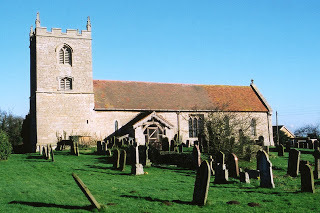 St. Denys Church ofEngland in KirkbyLaThorpe, Lincolnshire,
St. Denys Church ofEngland in KirkbyLaThorpe, Lincolnshire, where William Dyer was baptized in 1609.
St.Denys is a parish churchbuilt and improved in stages over the 12th, 13th, 14th,and 15th centuries. The chancel was rebuilt 1854-55, and restored1911-12. Perhaps William's parents, who were land-owning farmers there (asopposed to tenants), are buried in the church or churchyard. William's father (also William Dyer) was a churchwarden there for several years.
William Dyer,1609-1677, is scarcely known today, except as the husband of the Quakerconvert, Mary Barrett Dyer, who was hanged for civil disobedience to thePuritan theocracy in Massachusetts.That's not how it was during his lifetime!
William was an apprentice and then guild member in London, emigratedto Massachusetts in 1635, was a clerk-recorder-commissioner for Massachusettsand Rhode Island governments, the co-founder of Portsmouth and Newport, amilitia captain, the first attorney-general of Rhode Island, and the firstadmiral for the United Colonies, appointed by Sir Henry Vane the Younger (lordof Raby) in1652. Dyer was also solicitor-general of Rhode Island in 1657. He was instrumental in the colonycharters (he may have drafted them from sessions with the other colony leaders),he was named in the 1663 Rhode Island royal charter, and he was author of a businessproposal to King Charles II. He was trained for leather-goods importing in theFishmongers guild (so he was probably also skilled in many aspects of seafoodmarketing and customs/duties/inspections).
Dyer owned properties in Boston, Portsmouth, and Newport. He had a largefarm at Newportwith horses and tobacco, and traded with Indians for venison, corn, and othergoods. We know that he was a mariner from his trading and admiralty duties, soI presume that William was also a primary mover and shaker in developing thewharves and port facilities that made Newport one of three great harbors in NewEngland (besides Boston and New York). He was the father of six children withMary Dyer, and another child with his second wife. There are no known portraitsof William Dyer.
All this from the farm boy out of Kirkby LaThorpe!
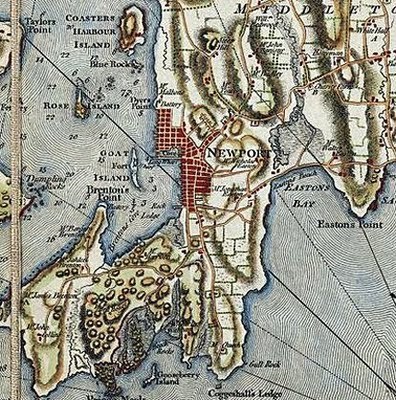 Dyer's Point, now Ft. Greene, is due east from Rose Island.
Dyer's Point, now Ft. Greene, is due east from Rose Island.William died late in 1677, and was buried (probably with hisfirst wife Mary and some of their children) on the family burial ground at theDyer farm in Newport, south of Coddington Cove and east of Coaster's Island. A 1777 map shows a tiny projection as Dyer's Point, which is now Battery Park / Ft. Greene, justsouth of the Newport Bridge--I imagine that Dyer's Point was part of his property. During the Revolutionary War, the British forces that held Aquidneck Island leveled orchards and buildings in and around Newport for clear shooting. The artillery array gave it the name of battery, ergo, Battery Park.
Eventually, the farmland was repurposed and subdivided, andafter the American Civil War, a naval college was built on Coaster's Island and a naval stationcomplex was developed on what had been the Dyer farm, 250 years earlier. Courtrecords indicate that Dyers and Coddingtons had properties bordering one withthe other, and that due to politics and land disputes, they were not exactlylove-your-neighbor types during the 1650s and 1660s.
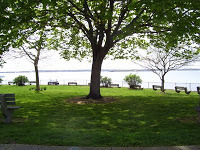 Battery Park at Dyer's PointSurely Admiral William Dyer would be very proud of hislegacy with the port and the naval complex! Wouldn't it be a good thing for hisdescendants to propose, fund, and place a historical marker in that vicinity,to the honor of William Dyer? I suggest Battery Park, formerly Dyer's Point, would bejust the spot!
Battery Park at Dyer's PointSurely Admiral William Dyer would be very proud of hislegacy with the port and the naval complex! Wouldn't it be a good thing for hisdescendants to propose, fund, and place a historical marker in that vicinity,to the honor of William Dyer? I suggest Battery Park, formerly Dyer's Point, would bejust the spot!
Published on September 16, 2011 09:30
September 12, 2011
What did Mary Dyer look like?
© Christy K. Robinson
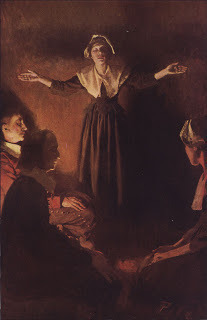 Mary Dyer at prayer, a Howard Pyle painting
Mary Dyer at prayer, a Howard Pyle paintingThe few illustrations we have of Mary Dyer, made 250-300 yearsafter her death, show a plain, slim, ageless woman in very severe clothing, herhair contained under a starched cap. No one knows what physical characteristicsshe had, though several artists have made their own interpretations, includingthe 1958 statues in Boston and Philadelphia, and the paintings of HowardPyle in the early 20th century.
In mid-17th-century Europe and England, women'sfashions were all over the board. The country women wore long, full skirts andkept their shoulders and arms covered in long-sleeved jackets. Middle-class merchants'wives also wore clothes that covered them, though they tucked their overskirtsabove their petticoats. Ladies of the court, and nobility, wore gowns of silkthat were turned back to the elbow, and revealed their bare shoulders andbosoms, right down to the areola, though for some reason, they covered theircleavage with a flower or long necklace pendant.
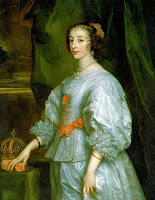 Queen Henrietta Maria, French-princess-turned-English-queen of Charles I.
Queen Henrietta Maria, French-princess-turned-English-queen of Charles I. Click to enlarge for gorgeous detail. In contrast, Queen Henrietta Maria was Catholic, anddressed more conservatively than Puritans or Anglicans. She influenced hairstyles, as we learnfrom portraits and woodcuts of other women of the day. She had ringlets around her face, andpulled her hair back with masses of ringlets behind her ears. Many women copiedthat style for formal occasions and portrait sittings. Perhaps they wore a hator cap at other times.
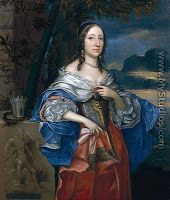 Lady Elizabeth Cromwell
Lady Elizabeth CromwellMrs. Oliver Cromwell, wife of theultra-Puritan Lord Protector of the Realm between the beheading of Charles Iand the restoration of the monarchy, is shown in a portrait wearing a colorful, expensive, low-cutgown—with pearls at her neck.
But in colonial New England, three thousand miles away fromcorrupt Babylon, men were building the NewJerusalem, the cultural Zionwhich would contain the saints of God. In this time of God's judgment, the saints ought to be dressed soberly.
Jewelry and cosmetics were forbidden in Puritan culturethroughout the 17th century, as something the wicked Jezebel would wear—or thefeared, hated Catholics, who wore crosses or saint medals, which wereinterpreted as idols or pagan amulets. (Again, note the relative lack of ornamentationon the Catholic Queen!)
Mary Winthrop Dudley, daughter and daughter-in-law ofstrict, legalistic Massachusetts governorsJohn Winthrop and Thomas Dudley, wrote letters to friends in England, lamenting the Puritan ban on stylishclothes in America.She disliked the harsh frontier life and the dress expectations placed uponher. She died in 1643, one day before her four-year-old son also died, never having returnedto Englandfor a visit.
Gold and silver embroidery were banned in 1634 Boston, as wasparticularly fancy lace. Women covered their hair with simple caps. At onepoint, the religious zealot Gov. John Endecott proposed that women wear veils,but that restriction was discarded because the women would have rebelledagainst their husbands. (You think??)
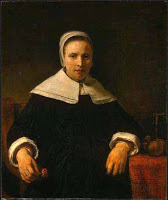 AnneDudley Bradstreet AnneDudley Bradstreet, America'sfirst poetess and daughter of the ultra-conservative Thomas Dudley, wore theclothing of a virtuous matron of high status, blackest black with plain collar and cuffs.
AnneDudley Bradstreet AnneDudley Bradstreet, America'sfirst poetess and daughter of the ultra-conservative Thomas Dudley, wore theclothing of a virtuous matron of high status, blackest black with plain collar and cuffs. Who decided what women wore? Men. But who wore lace collarsand cravats and elaborate periwigs for official occasions? Men. They pointedtheir beards as King Charles did, and dandified their mustaches, curled theirlong hair. Their silk brocade waistcoats (vests) were richly decorated withembroidery, and their wives (including Mrs. Endecott) employed lace makers tomake collars for them. Colorful ribbon rosettes tied their breeches at theknee, and tied their shoes.
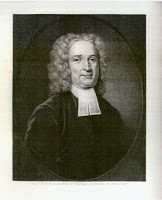 Rev. John Cotton, 1638In 1692, Rev. John Cotton's grandson, Cotton Mather (whowore a wig like his grandfather and all men of standing in the community), preached and then published a sermon called "Ornaments forthe Daughters of Zion." You can be quite sure that Rev. Mather was notexactly for ornaments! The sermonpropounded, "If a woman spends more time in dressing than in praying or inworking out her own salvation, her dress is but the snare of her soul." ByMather's time, the churches had an attendance very similar to today's mainlinechurches: two-thirds of the members were middle-aged and older women. Soperhaps the audience he intended to reach didn't get the memo.
Rev. John Cotton, 1638In 1692, Rev. John Cotton's grandson, Cotton Mather (whowore a wig like his grandfather and all men of standing in the community), preached and then published a sermon called "Ornaments forthe Daughters of Zion." You can be quite sure that Rev. Mather was notexactly for ornaments! The sermonpropounded, "If a woman spends more time in dressing than in praying or inworking out her own salvation, her dress is but the snare of her soul." ByMather's time, the churches had an attendance very similar to today's mainlinechurches: two-thirds of the members were middle-aged and older women. Soperhaps the audience he intended to reach didn't get the memo. You may have read Nathaniel Hawthorne's novel, The Scarlet Letter, in which a woman of Governor Endecott's Salem was forced to weara scarlet A for Adulteress. But did you know that in 1634, Robert Cole, "havingbeen oft punished for drunkenness, was now ordered to wear a red D about hisneck for a year." There's no record whether his scarlet letter cured hisalcoholism.
In her presentation of herself and her family, a woman had to tread a narrow course. Shewas expected to dress to meet her husband's social status. A goldsmith's ortailor's wife should enhance her husband's reputation by showing that herhusband was successful and popular in his trade, but she should never "getabove her station" by dressing like the nobility, even if she could afford it. Andshe was expected to show her husband's (not her) godliness by her manner ofdress and behavior.
Most clothes for everyday work in the home, shop, or garden wereprimary-colored, homespun, calico print, or brown, not the severe black andwhite that's been depicted in illustrations of the Pilgrims or the first colonists.Portraits were expensive, and only depicted the highest-income ormost-influential colonists, who wore black, an expensive, high-status color,with white collars, cuffs, or shirts, and no jewelry for either gender.
How did Mary Dyer appear to her associates in England and America? There are no portraits of Mary Dyer made in her lifetime,and no descriptions of her clothing styles. But because of her status as wifeof a merchant and government official, we may be confident that she waswell-dressed for each occasion, and current in fashions.When she became a Quaker, sometime in the last five to seven years of her life, she probably adopted plainer clothing, but still of high-quality material.
Here is the way Mary was described by observers: a person of no mean [inferior or low-class] extract or parentage possessing a piercing [perceptive, acute] knowledge of many things comely [pleasing in appearance] stature comely countenance [facial appearance]wonderful sweet and pleasant discoursefit for great affairscomely, grave [grounded and dignified] womanhaving a husband of great estate [political/social class, or wealth] a mother of children [eight pregnancies, six living children]goodly personage [distinction, importance]one of a good report [reputation]very proper [appropriate, fit, suitable]very fair [pretty, comely, lovely, blond, pale] woman
This suggests that Mary dressed carefully and appropriately,in what men perceived as a modest, Christian way. But it wasn't her clothingthat defined her. She was noted for her lovely character and demeanor. Surelythat was the sort of thing the apostles envisioned when they counseled women tolet their beauty come from godliness.
Iwant women to get in there with the men in humility before God, not primpingbefore a mirror or chasing the latest fashions but doing something beautifulfor God and becoming beautiful doing it. 1Timothy 2:9-10
In the end, which is more important—that we know if Mary Dyerhad blond or brown hair, if she had large green eyes, a delicate nose, or fulllips, or that she was admired for the beauty of who she was and how her selfless actions influenced people for centuries to come?
ClickHERE for images of clothing worn in the 1630s through 1650s, during MaryDyer's adulthood.
Published on September 12, 2011 21:34
September 11, 2011
The Little Ice Age: coldest in 17th century
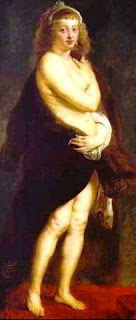 Rubens: The Fur Cloak, about 1636-1639.Is there globalcooling in our future? Scientists are predicting a period of less solaractivity. See Associated Press article following. Who knows? Perhaps our future will mirror our predecessors' experience.
Rubens: The Fur Cloak, about 1636-1639.Is there globalcooling in our future? Scientists are predicting a period of less solaractivity. See Associated Press article following. Who knows? Perhaps our future will mirror our predecessors' experience.Our ancestors survived conditions with considerably lessresources than we have available. There was no central heating in their homesand shops, of course, and fuel (peat, coal, and wood) was just as expensive, ormore so, as the fuels we consume today. Most people just couldn't afford theluxury of warmth in winter. They didn't change clothes or bathe much, especiallyin cold weather when they'd have to haul and heat water. They shared beds neara kitchen hearth, too.
This is just my observation from studying genealogy, notbacked up with statistics, but it looks like family size burgeoned during theglobal temperature dip of the 16th and 17th centuries:maybe the long, freezing nights were not all that boring! Certainly, a numberof family members of William and MaryBarrett Dyer had birthdays in September through December. So we can make an educated guessabout what happened during the preceding January, February, and March deep freezes. It didn't hurt that the Puritans took the "Be fruitful and multiply" command from Creation very seriously!
The Little Ice Age, from about 1317-1800, began withcatastrophic floods, crop failure, and domestic animal deaths (which brought oneconomic depression), harsh winters—and starvation. Epidemics raged unchecked,and millions died in the bubonic plague outbreak in 1348-1350. Because so manylaborers (peasants tied to the land, who owed service to their landlords) died,cathedral and castle building ground to a halt for years.
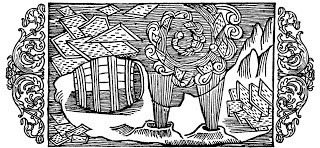 Iceland surrounded by icebergs, 17th centuryOf course our ancestors knew nothing about it, but theyexperienced the effects of a plunge in sunspot activity in the 1600s, whichcorresponded with the coldest years of the Little Ice Age. Specifically duringMary Dyer's lifetime, 1611-1660, there was the time of famines, waves ofbubonic plague across Europe, the Thirty Years War, the Great Migration to America, the English Civil War, and theexplosion of African slave trade to the Americasand Europe. On America's east coast, there wereharvest failures, starvation, epidemics of smallpox and yellow fever, and pestplagues. Iceland'sports were ice-bound by miles for several years, and trade and passengershipping from Europe was forced far south toavoid sea ice. Boston Harbor (sea water) frozeover for two to three miles out, hard enough to walk on, for two weeks at atime.
Iceland surrounded by icebergs, 17th centuryOf course our ancestors knew nothing about it, but theyexperienced the effects of a plunge in sunspot activity in the 1600s, whichcorresponded with the coldest years of the Little Ice Age. Specifically duringMary Dyer's lifetime, 1611-1660, there was the time of famines, waves ofbubonic plague across Europe, the Thirty Years War, the Great Migration to America, the English Civil War, and theexplosion of African slave trade to the Americasand Europe. On America's east coast, there wereharvest failures, starvation, epidemics of smallpox and yellow fever, and pestplagues. Iceland'sports were ice-bound by miles for several years, and trade and passengershipping from Europe was forced far south toavoid sea ice. Boston Harbor (sea water) frozeover for two to three miles out, hard enough to walk on, for two weeks at atime. Journal of GovernorJohn Winthrop—January 1638 (when the Dyers were still living in Boston but preparing to move to Portsmouth, Rhode Island):
"About thirtypersons of Boston going out in a fair day to Spectacle Island to cut wood, (thetown being in great want thereof,) the next night the wind rose so high at N.E.with snow, and after at N.W. for two days, and then it froze so hard, as thebay was all frozen up, save a little channel. In this twelve of them gateto the Governor's Garden [an island], and seven more were carried in the ice ina small skiff out at Broad Sound, and kept among Brewster's Rocks, without foodor fire, two days, and then the wind forbearing, they gate to Pull-in Point, toa little house there of Mr. Aspenwall's. Three of them got home the next dayover the ice, but their hands and feet frozen. Some lost their fingers andtoes, and one died. The rest went from Spectacle Islandto the main, but two of them fell into the ice, yet recovered again. In thisextremity of weather, a small pinnace was cast away upon Long Island [in Boston Harbor]by Natascott, but the men were saved and came home upon the ice."
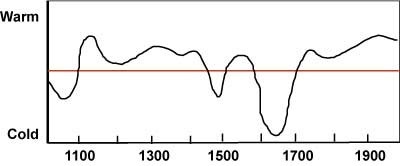 Little Ice Age severity, AD1000-2000 The Little Ice Age "peaked" in Mary Barrett Dyer'slifetime—the coldest years in many centuries were those she spent in colonial America. Thisgraph shows the severity of winters in Europe and North America from 1000-2000 AD. The absolute coldest period, 1600-1675,coincides with William and Mary Dyer's life spans.
Little Ice Age severity, AD1000-2000 The Little Ice Age "peaked" in Mary Barrett Dyer'slifetime—the coldest years in many centuries were those she spent in colonial America. Thisgraph shows the severity of winters in Europe and North America from 1000-2000 AD. The absolute coldest period, 1600-1675,coincides with William and Mary Dyer's life spans. The Dyers lived in Bostonfrom 1635 to the spring of 1638, then co-founded Portsmouth, Rhode Island,about 60 miles away. One year later, they co-founded the city of Newport, Rhode Island, where they developed a large farm and theseaport.
When Mary Dyer was making a winter trip back to America after several years in England, her ship diverted to Barbadosbecause of severe storms. From a letter written in Barbados on Feb 25, 1657:
"A ship came in hither, whichwas going to New England, but the storms were so violent that they were forced to come hither,[until] the winter there was nearly over. In this ship were two Friends, AnneBurden of Bristol, and one Mary Dyer from London; both lived in NewEngland formerly, and were members cast out of their [Puritan] churches. Marygoes to her husband who lives upon Rhode Island..."
A NASA websitesays, "During the coldest part of the Little Ice Age, from 1645 to 1715, thereis believed to have been a decrease in the total energy output from the Sun, asindicated by little or no sunspot activity. Known as the Maunder Minimum,astronomers of the time observed only about 50 sunspots for a 30-year period asopposed to a more typical 40-50,000 spots. The Sun normally shows signs ofvariability, such as its eleven-year sunspot cycle. Within that time, it goesfrom a minimum to a maximum period of activity represented by a peak in sunspotsand flare activity."
More from NASA: "Between the mid-1600s and the early 1700s the Earth's surfacetemperatures in the Northern Hemisphere appear to have been at or near theirlowest values of the last millennium. European winter temperatures over thattime period were reduced by 1.8 to 2.7 degrees Fahrenheit (1-1.5 Celsius). Thiscool down is evident through derived temperature readings from tree rings andice cores, and in historical temperature records, as gathered by the University of Massachusetts-Amherstand the University of Virginia."

Goodnight sun: Scientists predict sunspots mightdisappear for yearsBy: Associated PressUpdated June 15,2011
WASHINGTON- The sun is heading into an unusual and extended hibernation, scientistspredict. Around 2020, sunspots may disappear for years, maybe decades.
But scientists say it is nothing to worry about. Solar stormactivity has little to do with life-giving light and warmth from the sun. Theeffects from a calmer sun are mostly good.
There'd be fewer disruptions of satellites and powersystems. And it might mean a little less increase in global warming. It'shappened before, but not for a couple centuries.
"The solar cycle is maybe going into hiatus, sort of likea summertime TV show," said National Solar Observatory associate directorFrank Hill, the lead author of a scientific presentation at a solar physicsconference in New Mexico.
Scientists don't know why the sun is going quiet. But allthe signs are there. Hill and colleagues based their prediction on threechanges in the sun spotted by scientific teams: Weakening sunspots, fewerstreams spewing from the poles of the sun's corona and a disappearing solar jetstream.
Those three cues show, "there's a good possibility that thesun could be going into some sort of state from which it takes a long time torecover," said Richard Altrock, an astrophysicist at the Air Force ResearchLaboratory and study co-author.
The prediction is specifically aimed at the solar cyclestarting in 2020. Experts say the sun has already been unusually quiet forabout four years with few sunspots -- higher magnetic areas that appear as darkspots.
The enormous magnetic field of the sun dictates the solarcycle, which includes sunspots, solar wind and ejection of fast-movingparticles that sometimes hit Earth. Every 22 years, the sun's magnetic fieldswitches north and south, creating an 11-year sunspot cycle. At peak times,like 2001, there are sunspots every day and more frequent solar flares andstorms that could disrupt satellites.
Earlier this month, David Hathaway, NASA's top solar stormscientist, predicted that the current cycle, which started around 2009, will bethe weakest in a century. Hathaway is not part of Tuesday's [June 14, 2011]prediction.
Altrock also thinks the current cycle won't have much solaractivity. He tracks streamers from the solar corona, the sun's outer atmosphereseen during eclipses. The streamers normally get busy around the sun's poles afew years before peak solar storm activity. That "rush to the poles" would havehappened by now, but it hasn't and there's no sign of it yet. That also meansthe cycle after that is uncertain, he said.
Matt Penn of the National Solar Observatory, another studyco-author, said sunspot magnetic fields have been steadily decreasing instrength since 1998. If they continue on the current pace, their magneticfields will be too weak to become spots as of 2022 or so, he said.
Jet streams on the sun's surface and below are also earlyindicators of solar storm activity, and they haven't formed yet for the 2020cycle. That indicates that there will be little or delayed activity in thatcycle, said Hill, who tracks jet streams.
"People shouldn't be scared of this," said David McComas, ascientist at the Southwest Research Institute in San Antonio, who wasn't part of the team."This is about the magnetic field and the ionized gas coming out of the sun.It's a reduction in that, not the light and the heat."
There are questions about what this means for Earth'sclimate. Three times in the past the regular 11-year solar cycle has gone on anextended vacation -- at the same time as cool periods on Earth.
Skeptics of man-made global warming from the burning offossil fuels have often pointed to solar radiation as a possible cause of awarming Earth, but they are in the minority among scientists. The Earth haswarmed as solar activity has decreased.
Andrew Weaver, a climate scientist at the University of Victoria,said there could be small temperature effects, but they are far weaker than thestrength of man-made global warming from carbon dioxide and methane. He notedthat in 2010, when solar activity was mostly absent, Earth tied for its hottestyear in more than a century of record-keeping.
Hill and colleagues wouldn't discuss the effects of a quietsun on temperature or global warming.
"If our predictions are true, we'll have a wonderfulexperiment that will determine whether the sun has any effect on globalwarming," Hill said.
Published on September 11, 2011 15:41
September 7, 2011
The great New England quake of 1638
© Christy K. Robinson
The Hutchinsonians (followers of Anne Hutchinson's religiousfaction) had been in Portsmouth, Rhode Island, for about a monthafter having been exiled from Massachusetts Bay Colony. On Tuesday, June 1, 1638, at2:00 pm, when New England was enjoying a lovely, sunny day, an earthquake struckNew Hampshire, Massachusetts,Connecticut, and Rhode Island. The epicenter was in New Hampshire, and of about 6.5 - 7.0 magnitude,according to modern seismologists, based on its duration of four minutes. There was a large aftershock about 30 minutesafter the main shock, and many more tremors before the earth stilled aboutthree weeks later—just in time for a full eclipse of the moon, which showeditself a dried-blood color.

The moon turning to blood is another apocalyptic sign. Revelation 6:12 describes the end-times that the Puritans believed were upon them, "and, lo, there was a great earthquake; and the sun became black as sackcloth of hair, and the moon became as blood." Another prophecy of the end was in Acts of the Apostles 2:20: "The sun shall be turned into darkness, and the moon into blood, before the great and notable day of the Lord come." The fully-eclipsed blood moon was observed in Rhode Island. (Can you guess by whom? There was only the one settlement, at Portsmouth! Providence Plantation was on mainlaind, not on Aquidneck/Aquiday Island, later called Rhode Island.)
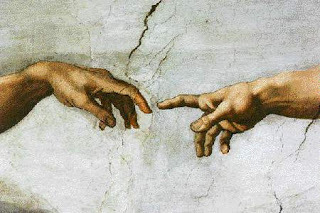 The hand of God (right) animates Adam.
The hand of God (right) animates Adam.Earthquakes and other natural phenomena (comets, eclipses,great storms, famines, epidemics, plagues of pests) were considered to bedirect messages from the hand of God, to display his displeasure at humansinfulness. In the case of the 1638 earthquake, those recording the historybelieved they were of God's Elect (people set apart to be saved from wrath and hell), so the message must be for someone else—the"someones" who followed Anne Hutchinson in exile to Rhode Island, that's who! (Between 50 and 75families, including William and Mary Dyer.) The "someones" who had defied Massachusetts Bay laws to speak and believe as God ledthem, instead of conforming to the theocratic, autocratic government there. The"someones" who, after repeated "loving demonstrations" of their error, hadrefused to recant. Well, then, bring on the judgment for those damned heretics!
We have a very good idea of what Anne Hutchinson and MaryDyer were doing at the time of the earthquake, thanks to Gov. John Winthrop,who tells us that they were having a prayer meeting, as they'd done for severalyears in Boston.When the quake struck (no doubt amplified by the marshes and liquefied soil ofthe island, but causing no permanent damage because the settlers were housed in wigwams while building their homes), the Hutchinsonians were convinced that just as on the Day ofPentecost, 50 days after Christ's resurrection, they were being blessed andhonored by the descent of the Holy Spirit, giving them spiritual gifts inconfirmation that they were firmly set in God's will.
Perception of curse or blessing depends on where you stand.
There are several contemporary descriptions of the event.
William Bradford was the governor of the Pilgrims'Plymouth Colony, Massachusetts.William Bradford, Morison Edition, Chapter29, pp. 302-303: This year, about the first or second of June,was a great and fearful earthquake. It was in this place heard before it wasfelt. It came with a rumbling noise or low murmur, like unto remote thunder. Itcame from the northward and passed southward; as the noise approached nearer,the earth began to shake and came at length with that violence as causedplatters, dishes and suchlike things as stood upon shelves, to clatter and falldown. Yea, persons were afraid of the houses themselves. It so fell out that atthe same time divers of the chief of this town were met together at one house,conferring with some of their friends that were upon their removal from theplace, as if the Lord would hereby show the signs of His displeasure, in theirshaking a-pieces and removals one from the other. However, it was very terriblefor the time, and as the men were talking in the house, some women and otherswere without the doors, and the earth shook with that violence as they couldnot stand without catching hold of the posts and pales that stood next to them.And about half an hour or less came another noise and shaking, but neither soloud or strong as the former, but quickly passed over so it ceased. It was notonly on the seacoast, but the Indians felt it within land, and some ships thatwere upon the coast were shaken by it."
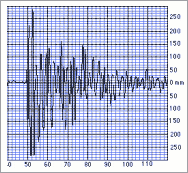 Seismograph of 7.0 quake
Seismograph of 7.0 quake Governor John Winthrop of Massachusetts Bay Colony, who hadbeen extremely ill and nearly died during the month of May, recorded in hisjournal:
--June 1. Between three and four in the afternoon, being clear, warm weather, the wind westerly, there was a great earthquake. It came with a noise like a continued thunder or the rattling of coaches in London, but was presently gone. It was at Connecticut, at Narragansett, at Pascataquack, and all the parts round about. It shook the ships, which rode in the harbor, and all the islands, etc. The noise and the shakings continued about four minutes. The earth was unquiet twenty days after, by times.
Winthrop also recorded a hearsay account of the earthquake in Rhode Island. He may have receivedinformation from Dr. John Clarke, or seen a letter from William Hutchinson toRev. John Cotton. Winthropwrote in April 1639:"On the first of June 1638, there was anearthquake which continued about four minutes and left the earth in an unquietcondition for twenty days afterwards. Mrs. Hutchinson and some of her adherentshappened to be at prayer when the earthquake was at Aquiday [Portsmouth, RhodeIsland], etc., and the house being shaken thereby, they were persuaded, (and boastedof it,) that the Holy Ghost did shake it in coming down upon them, as he didupon the apostles" [at Pentecost. Easter had been on April 12, so Pentecost wouldhave been on June 1—not that anyone but Catholics celebrated the church festivals at that time!]
Letter from Rev. Roger Williams of Providence, Rhode IslandFor his MuchHonored Mr. Governor, John Winthrop.Providence, [June, 1638.] SIR,—Isometimes fear that my lines are as thick and over busy as the musketoes,&c., but your wisdom will connive, and your love will cover, &c. Twothings at present for information. First in the affairs of the MostHigh; his late dreadful voice and hand: that audible and sensible voice, theEarthquake. All these parts felt it, (whether beyond the Narragansett Iyet learn not), for myself I scarce perceived ought but a kind of thunder and agentle moving, &c., and yet it was no more this way to many of our own andthe natives' apprehensions, and but one sudden short motion. The youngernatives are ignorant of the like: but the elder inform me that this is thefifth within these four score years in the land: the first about three scoreand ten years since [1568]: the second some three score and four years since[1574], the third some fifty-four years since [1584], the fourth some forty-sixsince [1592]: and they always observed either plague or pox or some otherepidemical disease followed; three, four or five years after the Earthquake,(or Naunaumemoauke, as they speak). He be mercifully pleased himself tointerpret and open his own riddles, (and grant if it be pleasing in his eyes)it may not be for destruction, and but (as the Earthquake before the Jailor'sconversion) a means of shaking and turning of all hearts, (which are his,)English or Indian, to him. To further this (if the Lord please) the Earthquakesensibly took about a thousand of the natives in a most solemn meeting forplay, &c. ROGER WILLIAMS.
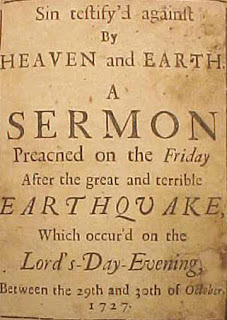 1727 quake sermon shows connection between heaven and earth
1727 quake sermon shows connection between heaven and earthWonder-working providence of SionsSaviour in New England, Volume 2By Rev. Edward Johnson Chap. XII.OF the great Earthquake in New England, and of the wosnll end of some erroniouspersons, with the first foundation of Harverd Colledge. This yeare, the first day of the Fourth Month[June], about two of the clock in the after-noone, the Lord caus'd a great andterrible Earth-quake, which was generall throughout all the EnglishPlantations; the motion of the Earth was such, that it caused divers men (thathad never knowne an Earth-quake before) being at worke in the Fields, to castdowne their working tooles, and run with gastly terrified lookes, to the nextcompany they could meet withall; it came from the Westerne and uninhabitedparts of this Wildemesse…
Travels in New England and New-York By Timothy Dwight, 1822There are eight earthquakes recorded in the historyof New England. The first of them was on the 1st day of June, 1638, and is styled byDr. Trumbull, "a great and memorable earthquake." His account of itis the following:—" It came with a report like continued thunder, or therattling of numerous coaches upon a paved street. The shock was so great, thatin many places the tops of the chimnies were thrown down, and the pewter fellfrom the shelves. It shook the waters and ships in the harbours, and all theadjacent islands. The duration of the sound and tremor was about four minutes.The earth at turns was unquiet for nearly twenty days. The weather was clear,the wind westerly, and the course of the earthquake from west to east."
SpecialPublication No. 149DEPARTMENT OF COMMERCE, U. S. COAST AND GEODETIC SURVEYE. LESTER JONES.DIRECTOREARTHQUAKE HISTORY OF THE UNITED STATES, Exclusiveof the Pacific RegionBY N. H. HECK1638. June1 or 3.This seems to have been quite a violent shock. At Plymouth, Mass.,people had to hold on to objects to keep from falling. Ships at sea wereshaken. It was felt in Connecticutand at Narragansett.
For moreinformation on New England earthquakes, click HERE .
Published on September 07, 2011 01:10
September 5, 2011
Mary Dyer's "monster"
© Christy K. Robinson
***Please close page if you're sensitive to images of fetuses, and accept my apology. I think the images are necessary to illustrate the article.***
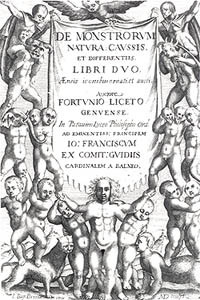 On October 17, 1637, Mary Dyer gave birth to a stillborn,deformed baby girl, two months prematurely. This was Mary's third time inchildbirth: her first son William had died immediately after being christened,and was buried in England.Her second son, Samuel, was born in autumn 1635, and christened by Rev. JohnWilson, ironically the man who would taunt Mary at her execution. This babygirl was never christened and had no name.
On October 17, 1637, Mary Dyer gave birth to a stillborn,deformed baby girl, two months prematurely. This was Mary's third time inchildbirth: her first son William had died immediately after being christened,and was buried in England.Her second son, Samuel, was born in autumn 1635, and christened by Rev. JohnWilson, ironically the man who would taunt Mary at her execution. This babygirl was never christened and had no name.
Anne Hutchinson and Jane Hawkins were the attending midwives.In October, Anne had been told to stand trial for heresy in early November,and it appears that William Dyer was away from Bostonfor at least a month at this time: either on a venison or corn-trading missionwith the Indians, or scouting land in Rhode Island on which to plant a town.
The seven-months-gestation child was born dead: it hadanencephaly and spina bifida malformations, according to a neurologist (seebelow). It was buried in an unknown location (not a consecrated cemetery) by Reverend John Cotton, teacherof the First Church of Boston, where the Hutchinsons and Dyers were members.The secret burial was based on old English law that stillborn babies should be buried deeply enough not to be disturbed by animals.
The existence of the baby was unknown to most people (and Isuspect its malformation was kept from Mary Dyer as a mercy), until AnneHutchinson's second trial for heresy and sedition in March 1638. Most of themen in the Hutchinson faction had gone on ascouting and surveying trip to Aquidneck Islandto arrange for their exodus in April 1638. So the governors and ministersarrayed themselves as prosecutors, jury, and judge against Anne, who was not allowed defense counsel.
At Anne's inevitable conviction, excommunication, andexpulsion from the meeting house, Mary Dyer stood up and walked out with Anne,holding her friend's hand for support. As they left the building, someone inthe crowd mentioned that Mary was the mother of a "monster."
Governor Winthrop, in his zeal to further prosecute Anne andher supporters, ordered the exhumation and examination of this monster, MaryDyer's baby, which had lain in the frozen ground for six months.
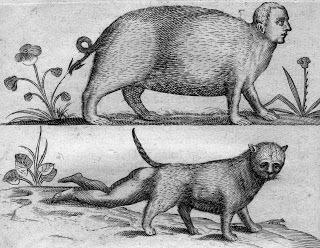 Illustration from De Monstrorum "Monster" was a term commonly used for morethan a hundred years in England,to include conjoined twins, congenital birth defects, stillborn malformedbabies, and even deformed living children. A 1634 book, De Monstrorum, illustrated human-beast hybrids that could come ofbestiality, and in the later 1630s, Governor Winthrop described a pig-humanhybrid with its human father's face. At Plymouth Colony, a young man was convicted and hanged for having carnal knowledge of farm animals. In such cases, following the Old Testament, both man andbeast were destroyed as punishment, and preventive notice to others.
Illustration from De Monstrorum "Monster" was a term commonly used for morethan a hundred years in England,to include conjoined twins, congenital birth defects, stillborn malformedbabies, and even deformed living children. A 1634 book, De Monstrorum, illustrated human-beast hybrids that could come ofbestiality, and in the later 1630s, Governor Winthrop described a pig-humanhybrid with its human father's face. At Plymouth Colony, a young man was convicted and hanged for having carnal knowledge of farm animals. In such cases, following the Old Testament, both man andbeast were destroyed as punishment, and preventive notice to others.
Usually, a monster birth was connected with the curse ofwitchcraft, or was proof of the mother's heresy to established Christian beliefsand behavior. In the 1650s, a rumor went around that monsters were born towomen who preached, or who had listened to a woman preacher—a direct referenceto Anne Hutchinson, Mary Dyer, and the many sects, including Quakers, that werespringing up with women in teaching and preaching roles.
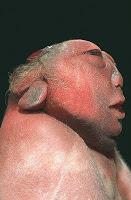 Anencephalic fetus In 1642 and 1644, Massachusetts Governor John Winthrop'saccount of Mary Dyer's 1637 stillborn baby's deformation was published in England with a forward by Rev. Thomas Welde, oneof Winthrop'scolleagues. In A Short Story of the Rise, Reign and Ruin of theAntinomians, Familists and Libertines That Infected the Churches of New England,Winthrop's text described Mary's daughter: "It was of ordinary bigness; it hada face, but no head, and the ears stood upon the shoulders and were like anape's; it had no forehead, but over the eyes four horns, hard and sharp; two ofthem were above one inch long, the other two shorter; the eyes standing out,and the mouth also; the nose hooked upward; all over the breast and back fullof sharp pricks and scales, like a thornback* [i.e., a skate or ray], the naveland all the belly, with the distinction of the sex, were where the back shouldbe, and the back and hips before, where the belly should have been; behind,between the shoulders, it had two mouths, and in each of them a piece of redflesh sticking out; it had arms and legs as other children; but, instead oftoes, it had on each foot three claws, like a young fowl, with sharp talons."
Anencephalic fetus In 1642 and 1644, Massachusetts Governor John Winthrop'saccount of Mary Dyer's 1637 stillborn baby's deformation was published in England with a forward by Rev. Thomas Welde, oneof Winthrop'scolleagues. In A Short Story of the Rise, Reign and Ruin of theAntinomians, Familists and Libertines That Infected the Churches of New England,Winthrop's text described Mary's daughter: "It was of ordinary bigness; it hada face, but no head, and the ears stood upon the shoulders and were like anape's; it had no forehead, but over the eyes four horns, hard and sharp; two ofthem were above one inch long, the other two shorter; the eyes standing out,and the mouth also; the nose hooked upward; all over the breast and back fullof sharp pricks and scales, like a thornback* [i.e., a skate or ray], the naveland all the belly, with the distinction of the sex, were where the back shouldbe, and the back and hips before, where the belly should have been; behind,between the shoulders, it had two mouths, and in each of them a piece of redflesh sticking out; it had arms and legs as other children; but, instead oftoes, it had on each foot three claws, like a young fowl, with sharp talons."
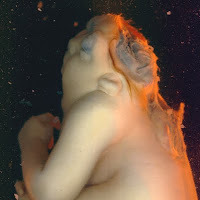 Anencephalic with spina bifida
Anencephalic with spina bifida
*Thornbackswere disdained as filth: William Wood wrote in New England's Prospect, p. 37, that "Thornebacke and Scates isgiven to the dogges, being not counted worth the dressing in many places."
Norman McNulty, MD, a neurologist, says of Winthrop's evaluation: "Anencephaly iscertainly part of the picture and it was probably some non-inheritablecongenital malformation that led to this malformation. Sometimes, in utero strokes very early indevelopment lead to lack of development of brain tissue (anencephaly) which isprobably what happened here."
Anencephalic babies usually don't live to birth; if theydo, they die within hours. They have only a brain stem and usually have othersevere defects, so it's impossible to sustain life. For more information onanencephaly, clickHERE. In addition to the anencephaly, the baby almost certainly had spina bifida. These compounded neural defects might have come from a diet poor in Vitamin B, from lead poisoning (eating and drinking vessels), or from using popular remedies that included mercury.
Mary Dyer's poor daughter was used as a sermon illustrationfor decades.
Edward Johnson, in Wonder-Working Providence, 1628-1651, wrote regarding the 1638 earthquake in New England, "yet was not this the first loud speaking hand of God againstthem; but before this the Lord hadpoynted directly to their sinne by a very fearfull Monster, that another ofthese women [Mary Dyer] brought forth, they striving to buryit in oblivion, but the Lord brought it to light, setting forth the view oftheir monstrous Errors in this prodigious birth."
There was even gossip that Sir Henry Vane the Younger, a one-termgovernor of Massachusetts and then a high official in English Parliament, hadan illicit affair with both Mary Dyer and Anne Hutchinson, which, because ofthe supposed utter abandon of morality, and Sir Henry's liberal religion and politics, hadresulted in both abnormal births. (Anne had a hydatidiform molar pregnancy terminate in the latespring of 1638, only months after Mary's stillbirth.)
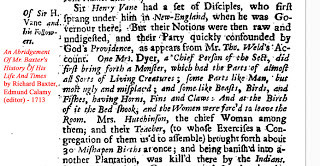 Sir Henry Vane had a set of Disciples, who first sprang underhim in New-England, when he was Governour there, But their Notions werethen raw and undigested, and their-Party quickly confounded by God's Providence, asappears from Mr. Tho. Weld's Account. One Mrs. Dyer, a 'ChiefPerson of the Sect, did first bring forth a Monster, which had theParts of almost all Sorts of Living Creatures; some Parts like Man, butmost ugly and misplac'd ; and some like Beasts, Birds, and Fishes,having Horns, Fins and Claws: And at the Birth of it the Bed shook., and theWomen were forced to leave the room. Mrs. Hutchinson, the chiefWoman among them; and their Teacher, (to whose Exercises a Congregationof them us'd to assemble) brought forth about 30 Mishapen Births atonce; and being banish'd into another Plantation, was kill'd there by the Indians.An Abridgement Of Mr.Baxter's History Of Young Sir Henry Vane, His Life And Times, by RichardBaxter, Edmund Calamy (editor) —1713: "ThePresbyterian view is given by Baxter: 'Sir H. Vane hada set of disciples who first sprang under him in New England. But their notions were then raw and undigested, and theirparty quickly confounded by God's providence.' Baxter's proofs of the divinedisfavor visited upon the New England Antinomians are certain monstrous birthswhich poor Mrs. Hutchinson and one of her female followers [Mary Dyer] broughtforth, — a sad and disgusting recital." Calamy's Abridgment of Baxter's Life of Young SirHenry Vane, pp. 98, 99.
Sir Henry Vane had a set of Disciples, who first sprang underhim in New-England, when he was Governour there, But their Notions werethen raw and undigested, and their-Party quickly confounded by God's Providence, asappears from Mr. Tho. Weld's Account. One Mrs. Dyer, a 'ChiefPerson of the Sect, did first bring forth a Monster, which had theParts of almost all Sorts of Living Creatures; some Parts like Man, butmost ugly and misplac'd ; and some like Beasts, Birds, and Fishes,having Horns, Fins and Claws: And at the Birth of it the Bed shook., and theWomen were forced to leave the room. Mrs. Hutchinson, the chiefWoman among them; and their Teacher, (to whose Exercises a Congregationof them us'd to assemble) brought forth about 30 Mishapen Births atonce; and being banish'd into another Plantation, was kill'd there by the Indians.An Abridgement Of Mr.Baxter's History Of Young Sir Henry Vane, His Life And Times, by RichardBaxter, Edmund Calamy (editor) —1713: "ThePresbyterian view is given by Baxter: 'Sir H. Vane hada set of disciples who first sprang under him in New England. But their notions were then raw and undigested, and theirparty quickly confounded by God's providence.' Baxter's proofs of the divinedisfavor visited upon the New England Antinomians are certain monstrous birthswhich poor Mrs. Hutchinson and one of her female followers [Mary Dyer] broughtforth, — a sad and disgusting recital." Calamy's Abridgment of Baxter's Life of Young SirHenry Vane, pp. 98, 99.
There's no record of what Mary Dyer or Anne Hutchinsonthought of their tragic pregnancies, because at that time, their emotions andsorrow didn't matter to the men who recorded history. They were adjudgedheretics and deserving of their misfortune. But my hunch is that after Anne'sdeath in 1643, Winthrop's publications in 1642 and 1644, the English Civil War had stabilized, and she was finished havingchildren and weaning them, and finally Edward Johnson's 1651 history book, Mary Dyer sailedfor Englandin early 1652. I believe her mission was to set the record straight about Anne Hutchinson, her mentor,friend, and mother figure. In England,Mary encountered a new sect that in some ways reflected the principles that Annehad taught 15 years before: they were the Quakers.
***Please close page if you're sensitive to images of fetuses, and accept my apology. I think the images are necessary to illustrate the article.***
 On October 17, 1637, Mary Dyer gave birth to a stillborn,deformed baby girl, two months prematurely. This was Mary's third time inchildbirth: her first son William had died immediately after being christened,and was buried in England.Her second son, Samuel, was born in autumn 1635, and christened by Rev. JohnWilson, ironically the man who would taunt Mary at her execution. This babygirl was never christened and had no name.
On October 17, 1637, Mary Dyer gave birth to a stillborn,deformed baby girl, two months prematurely. This was Mary's third time inchildbirth: her first son William had died immediately after being christened,and was buried in England.Her second son, Samuel, was born in autumn 1635, and christened by Rev. JohnWilson, ironically the man who would taunt Mary at her execution. This babygirl was never christened and had no name.Anne Hutchinson and Jane Hawkins were the attending midwives.In October, Anne had been told to stand trial for heresy in early November,and it appears that William Dyer was away from Bostonfor at least a month at this time: either on a venison or corn-trading missionwith the Indians, or scouting land in Rhode Island on which to plant a town.
The seven-months-gestation child was born dead: it hadanencephaly and spina bifida malformations, according to a neurologist (seebelow). It was buried in an unknown location (not a consecrated cemetery) by Reverend John Cotton, teacherof the First Church of Boston, where the Hutchinsons and Dyers were members.The secret burial was based on old English law that stillborn babies should be buried deeply enough not to be disturbed by animals.
The existence of the baby was unknown to most people (and Isuspect its malformation was kept from Mary Dyer as a mercy), until AnneHutchinson's second trial for heresy and sedition in March 1638. Most of themen in the Hutchinson faction had gone on ascouting and surveying trip to Aquidneck Islandto arrange for their exodus in April 1638. So the governors and ministersarrayed themselves as prosecutors, jury, and judge against Anne, who was not allowed defense counsel.
At Anne's inevitable conviction, excommunication, andexpulsion from the meeting house, Mary Dyer stood up and walked out with Anne,holding her friend's hand for support. As they left the building, someone inthe crowd mentioned that Mary was the mother of a "monster."
Governor Winthrop, in his zeal to further prosecute Anne andher supporters, ordered the exhumation and examination of this monster, MaryDyer's baby, which had lain in the frozen ground for six months.
 Illustration from De Monstrorum "Monster" was a term commonly used for morethan a hundred years in England,to include conjoined twins, congenital birth defects, stillborn malformedbabies, and even deformed living children. A 1634 book, De Monstrorum, illustrated human-beast hybrids that could come ofbestiality, and in the later 1630s, Governor Winthrop described a pig-humanhybrid with its human father's face. At Plymouth Colony, a young man was convicted and hanged for having carnal knowledge of farm animals. In such cases, following the Old Testament, both man andbeast were destroyed as punishment, and preventive notice to others.
Illustration from De Monstrorum "Monster" was a term commonly used for morethan a hundred years in England,to include conjoined twins, congenital birth defects, stillborn malformedbabies, and even deformed living children. A 1634 book, De Monstrorum, illustrated human-beast hybrids that could come ofbestiality, and in the later 1630s, Governor Winthrop described a pig-humanhybrid with its human father's face. At Plymouth Colony, a young man was convicted and hanged for having carnal knowledge of farm animals. In such cases, following the Old Testament, both man andbeast were destroyed as punishment, and preventive notice to others. Usually, a monster birth was connected with the curse ofwitchcraft, or was proof of the mother's heresy to established Christian beliefsand behavior. In the 1650s, a rumor went around that monsters were born towomen who preached, or who had listened to a woman preacher—a direct referenceto Anne Hutchinson, Mary Dyer, and the many sects, including Quakers, that werespringing up with women in teaching and preaching roles.
 Anencephalic fetus In 1642 and 1644, Massachusetts Governor John Winthrop'saccount of Mary Dyer's 1637 stillborn baby's deformation was published in England with a forward by Rev. Thomas Welde, oneof Winthrop'scolleagues. In A Short Story of the Rise, Reign and Ruin of theAntinomians, Familists and Libertines That Infected the Churches of New England,Winthrop's text described Mary's daughter: "It was of ordinary bigness; it hada face, but no head, and the ears stood upon the shoulders and were like anape's; it had no forehead, but over the eyes four horns, hard and sharp; two ofthem were above one inch long, the other two shorter; the eyes standing out,and the mouth also; the nose hooked upward; all over the breast and back fullof sharp pricks and scales, like a thornback* [i.e., a skate or ray], the naveland all the belly, with the distinction of the sex, were where the back shouldbe, and the back and hips before, where the belly should have been; behind,between the shoulders, it had two mouths, and in each of them a piece of redflesh sticking out; it had arms and legs as other children; but, instead oftoes, it had on each foot three claws, like a young fowl, with sharp talons."
Anencephalic fetus In 1642 and 1644, Massachusetts Governor John Winthrop'saccount of Mary Dyer's 1637 stillborn baby's deformation was published in England with a forward by Rev. Thomas Welde, oneof Winthrop'scolleagues. In A Short Story of the Rise, Reign and Ruin of theAntinomians, Familists and Libertines That Infected the Churches of New England,Winthrop's text described Mary's daughter: "It was of ordinary bigness; it hada face, but no head, and the ears stood upon the shoulders and were like anape's; it had no forehead, but over the eyes four horns, hard and sharp; two ofthem were above one inch long, the other two shorter; the eyes standing out,and the mouth also; the nose hooked upward; all over the breast and back fullof sharp pricks and scales, like a thornback* [i.e., a skate or ray], the naveland all the belly, with the distinction of the sex, were where the back shouldbe, and the back and hips before, where the belly should have been; behind,between the shoulders, it had two mouths, and in each of them a piece of redflesh sticking out; it had arms and legs as other children; but, instead oftoes, it had on each foot three claws, like a young fowl, with sharp talons."
 Anencephalic with spina bifida
Anencephalic with spina bifida*Thornbackswere disdained as filth: William Wood wrote in New England's Prospect, p. 37, that "Thornebacke and Scates isgiven to the dogges, being not counted worth the dressing in many places."
Norman McNulty, MD, a neurologist, says of Winthrop's evaluation: "Anencephaly iscertainly part of the picture and it was probably some non-inheritablecongenital malformation that led to this malformation. Sometimes, in utero strokes very early indevelopment lead to lack of development of brain tissue (anencephaly) which isprobably what happened here."
Anencephalic babies usually don't live to birth; if theydo, they die within hours. They have only a brain stem and usually have othersevere defects, so it's impossible to sustain life. For more information onanencephaly, clickHERE. In addition to the anencephaly, the baby almost certainly had spina bifida. These compounded neural defects might have come from a diet poor in Vitamin B, from lead poisoning (eating and drinking vessels), or from using popular remedies that included mercury.
Mary Dyer's poor daughter was used as a sermon illustrationfor decades.
Edward Johnson, in Wonder-Working Providence, 1628-1651, wrote regarding the 1638 earthquake in New England, "yet was not this the first loud speaking hand of God againstthem; but before this the Lord hadpoynted directly to their sinne by a very fearfull Monster, that another ofthese women [Mary Dyer] brought forth, they striving to buryit in oblivion, but the Lord brought it to light, setting forth the view oftheir monstrous Errors in this prodigious birth."
There was even gossip that Sir Henry Vane the Younger, a one-termgovernor of Massachusetts and then a high official in English Parliament, hadan illicit affair with both Mary Dyer and Anne Hutchinson, which, because ofthe supposed utter abandon of morality, and Sir Henry's liberal religion and politics, hadresulted in both abnormal births. (Anne had a hydatidiform molar pregnancy terminate in the latespring of 1638, only months after Mary's stillbirth.)
 Sir Henry Vane had a set of Disciples, who first sprang underhim in New-England, when he was Governour there, But their Notions werethen raw and undigested, and their-Party quickly confounded by God's Providence, asappears from Mr. Tho. Weld's Account. One Mrs. Dyer, a 'ChiefPerson of the Sect, did first bring forth a Monster, which had theParts of almost all Sorts of Living Creatures; some Parts like Man, butmost ugly and misplac'd ; and some like Beasts, Birds, and Fishes,having Horns, Fins and Claws: And at the Birth of it the Bed shook., and theWomen were forced to leave the room. Mrs. Hutchinson, the chiefWoman among them; and their Teacher, (to whose Exercises a Congregationof them us'd to assemble) brought forth about 30 Mishapen Births atonce; and being banish'd into another Plantation, was kill'd there by the Indians.An Abridgement Of Mr.Baxter's History Of Young Sir Henry Vane, His Life And Times, by RichardBaxter, Edmund Calamy (editor) —1713: "ThePresbyterian view is given by Baxter: 'Sir H. Vane hada set of disciples who first sprang under him in New England. But their notions were then raw and undigested, and theirparty quickly confounded by God's providence.' Baxter's proofs of the divinedisfavor visited upon the New England Antinomians are certain monstrous birthswhich poor Mrs. Hutchinson and one of her female followers [Mary Dyer] broughtforth, — a sad and disgusting recital." Calamy's Abridgment of Baxter's Life of Young SirHenry Vane, pp. 98, 99.
Sir Henry Vane had a set of Disciples, who first sprang underhim in New-England, when he was Governour there, But their Notions werethen raw and undigested, and their-Party quickly confounded by God's Providence, asappears from Mr. Tho. Weld's Account. One Mrs. Dyer, a 'ChiefPerson of the Sect, did first bring forth a Monster, which had theParts of almost all Sorts of Living Creatures; some Parts like Man, butmost ugly and misplac'd ; and some like Beasts, Birds, and Fishes,having Horns, Fins and Claws: And at the Birth of it the Bed shook., and theWomen were forced to leave the room. Mrs. Hutchinson, the chiefWoman among them; and their Teacher, (to whose Exercises a Congregationof them us'd to assemble) brought forth about 30 Mishapen Births atonce; and being banish'd into another Plantation, was kill'd there by the Indians.An Abridgement Of Mr.Baxter's History Of Young Sir Henry Vane, His Life And Times, by RichardBaxter, Edmund Calamy (editor) —1713: "ThePresbyterian view is given by Baxter: 'Sir H. Vane hada set of disciples who first sprang under him in New England. But their notions were then raw and undigested, and theirparty quickly confounded by God's providence.' Baxter's proofs of the divinedisfavor visited upon the New England Antinomians are certain monstrous birthswhich poor Mrs. Hutchinson and one of her female followers [Mary Dyer] broughtforth, — a sad and disgusting recital." Calamy's Abridgment of Baxter's Life of Young SirHenry Vane, pp. 98, 99. There's no record of what Mary Dyer or Anne Hutchinsonthought of their tragic pregnancies, because at that time, their emotions andsorrow didn't matter to the men who recorded history. They were adjudgedheretics and deserving of their misfortune. But my hunch is that after Anne'sdeath in 1643, Winthrop's publications in 1642 and 1644, the English Civil War had stabilized, and she was finished havingchildren and weaning them, and finally Edward Johnson's 1651 history book, Mary Dyer sailedfor Englandin early 1652. I believe her mission was to set the record straight about Anne Hutchinson, her mentor,friend, and mother figure. In England,Mary encountered a new sect that in some ways reflected the principles that Annehad taught 15 years before: they were the Quakers.
Published on September 05, 2011 13:29

